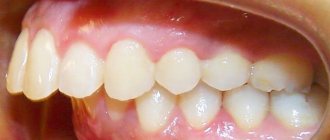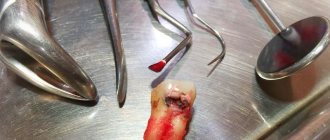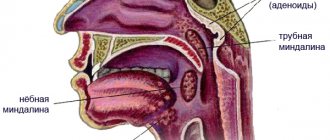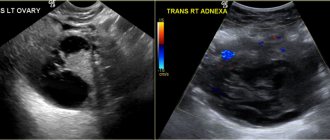Vegetative dystonia has many manifestations, for example, some patients experience numbness in the tongue due to VSD, a sore throat or disturbances in the processes of digestion and breathing. Many patients with numbness in the limbs, head or tongue use remedies to eliminate these symptoms, but they do not completely get rid of the problem.
Effective treatment of vegetative-vascular dystonia is based on eliminating the causes of the disorder. Thus, modern specialists have developed a set of methods to relieve nervous tension and reduce the production of adrenaline, which is one of the causes of unpleasant sensations. Neurologists, psychotherapists, cardiologists, and exercise therapy instructors provide high-quality treatment for VSD, which has various manifestations.
Numbness of the tongue
When the functions of the autonomic nervous system are disrupted, blood pressure changes, muscle tone increases, and blood vessels narrow. The resulting spasms lead to the tongue going numb during VSD. The cause of discomfort may be excessive production of adrenaline by the adrenal glands.
Numbness of the tongue can occur due to emotional stress, compression of blood vessels due to cervical osteochondrosis, as well as pathologies of the cardiovascular system. The patient's condition with VSD worsens as a result of worries due to numbness of the tongue and face. To normalize psycho-emotional standing and treat VSD, you should contact a specialist who will select safe and effective means.
Neurologists at the Yusupov Hospital have extensive experience in treating various types of vegetative-vascular dystonia. When a patient comes in with complaints of numbness of the tongue, a feeling of a lump in the throat, a diagnosis is carried out. The main diagnostic methods for VSD are:
- general examination of the patient;
- blood and urine tests;
- palpation;
- Magnetic resonance imaging.
Treatment of VSD at the Yusupov Hospital is carried out according to an individual program, which is developed by highly qualified specialists.
What other diseases cause numbness in hands, feet and tongue?
Lesions of the cervical, cranial, and lumbar nerves can cause numbness. But in addition to this, other symptoms are usually present: pain, tingling, dysfunction (claudication, arm weakness, slowness and blurred speech).
Metabolic diseases can also cause changes in sensitivity, including numbness of body parts. If you often limit yourself to meat, fish, eggs, and do not supplement your diet with synthetic vitamin B12, then this can cause metabolic disorders and cause weakness in your arms and legs.
Loss of sensation in the left hand may be one of the classic symptoms of myocardial infarction. At the same time, the general condition worsens, the person looks very pale or, on the contrary, turns red, dizziness or headache, a feeling of heaviness in the chest or a burning sensation appears.
A hernia in one part of the spine can put pressure on a nerve, causing pain or loss of sensation.
Decreased sensation in the feet can be a complication of diabetes. This is one of the first signs of diabetic foot and should be reported to your doctor as soon as possible.
Sore throat
Discomfort and sore throat with VSD occurs due to spasms of the muscles of the pharynx and larynx. If patients feel a lump in the throat during VSD, an experienced neurologist at the Yusupov Hospital will tell you how to get rid of this symptom.
A sore throat occurs in patients with VSD during the daytime. Many people experience serious stress when this symptom appears, as they consider discomfort in grief to be a manifestation of dangerous diseases, such as a malignant tumor or goiter of the thyroid gland. To eliminate throat discomfort, many people prefer to drink water, which brings temporary relief, but to completely eliminate the symptom, it is necessary to get rid of the root cause.
Diagnosis of strokes
First of all, it is necessary to conduct a detailed neurological examination. Instrumental diagnostic studies and laboratory tests are also prescribed. In case of a stroke, in the first hours, an MRI or CT scan of the brain is performed, if necessary, CT or MR angiography, color Doppler mapping of blood flow, ECG or Holter monitoring, echocardiography as indicated, monitoring of blood pressure, saturation, assessment of the risk of developing bedsores, assessment of swallowing function [ 1, 3, 6].
Tests for stroke
- Complete clinical blood test, including erythrocyte sedimentation rate (ESR).
- Biochemical blood test with determination of C-reactive protein and homocysteine, glucose level, platelet count, activated partial thromboplastin time, INR.
- Interleukin 10.
- Extended coagulogram.
- Determination of acid-base status.
- General urine analysis.
To prepare for neurosurgical intervention, a blood test is additionally performed for hepatitis, syphilis, HIV, blood group and Rh factor determination.
Sweating
Excessive sweating with VSD is a common symptom in which people try to get rid of the problem on their own. Self-medication for vegetative-vascular dysfunction can lead to the development of other manifestations of VSD.
Disorders in the functioning of the nervous system cause excessive sweating, which makes a person feel insecure. A lump in the throat with VSD and other symptoms if left untreated can cause consequences. Thus, with increased sweating, a favorable environment is created for the development of infections. The protective functions of the skin gradually deteriorate, so the skin can be affected by fungus.
To reduce sweating, specialists at the Yusupov Hospital recommend that patients get rid of bad habits, adhere to proper nutrition, and maintain a daily routine. During sessions, psychotherapists at the Yusupov Hospital help patients reduce anxiety and learn to relax.
Consequences of a stroke
There are transient ischemic attack (less than a day), minor stroke (from 1 day to 3 weeks) and stroke with persistent residual effects. The consequences of a stroke are expressed mainly in motor and sensory disorders, the formation of muscle contractures (pronounced constant restriction of movements in the joints), speech and swallowing disorders. General symptoms may also remain, including confusion, disturbances in thinking, will, and emotional regulation. Complications can develop: from epilepsy to bedsores, encephalopathy and anxiety-depressive syndrome [1, 3].
Advantages of treatment at the Yusupov Hospital
The Yusupov Multidisciplinary Hospital is a modern medical institution that maintains the tradition of attentive treatment and respect for each patient, which is especially important in the treatment of vegetative-vascular dystonia.
During consultations with patients complaining of a lump in the throat due to VSD, specialists from the Yusupov Hospital clearly explain how to get rid of the unpleasant sensations. When treating patients, only proven methods are used, so the services provided meet international standards.
The therapy program, compiled by highly qualified specialists at the Yusupov Hospital, allows patients to be relieved of the main disorder and its manifestations, such as dry throat during VSD, increased anxiety, profuse sweating, numbness of the tongue, disruption of the gastrointestinal tract, and panic attacks.
If you experience discomfort in the throat, numbness of the tongue or other unpleasant symptoms, contact the clinic to determine the cause. Pre-registration for a consultation with specialists allows patients to choose the most convenient time and avoid queues. Make an appointment with specialists at the Yusupov Hospital.
What is a stroke
The essence of a stroke is the cessation of blood supply and functioning of a part of the brain as a result of damage to a vessel.
The larger the affected area, the more severe the stroke. Necrosis of a portion of the brain substance is called an infarction [3]. There is a high risk of death in the first few hours, and then in the period up to 28 days after a vascular accident. The annual mortality rate from stroke in the Russian Federation is 374 cases per 100,000 [10]. In 2018, 35% of patients died in the acute period of stroke; by the end of the first year, this figure increases by 15%, and in general, in the first 5 years, the mortality rate of strokes is 44% [11]. The mortality rate from stroke was 92.9 per 100,000 population, and the hospital mortality rate was 19.1% [5].
Long-term disability is most likely for patients who have suffered a stroke. The prevalence of primary disability due to stroke in 2018 was 3.2 per 10 thousand population [2]. Of these, 31% need constant care, 20% have severe mobility limitations, and only 8% return to work [3]. The prevalence of recurrent strokes in 2014 was 0.79%, of which ischemic
strokes account for 87.5% [9].
Types of urticaria
There are several classifications of urticaria.
1. By time:
- acute – lasts up to 6 weeks;
- chronic – more than 6 weeks.
2. By nature:
- allergic (immune) - realized through the development of an immune reaction, often combined with other allergic diseases (bronchial asthma, rhinitis, conjunctivitis, dermatitis, etc.);
- non-allergic - through the direct release of histamine.
3. Due to:
— allergic urticaria
may cause:
- Food;
- taking medications;
- insect allergens (insect allergy);
- pollen allergens.
— non-allergic
form of the disease occurs due to a direct effect on the mast cell:
- physical factors - such as cold, heat, ultraviolet radiation, radiation, vibration, compression;
- chemical (provoking factors are solvents, acids, alkalis and other chemicals);
- certain medicines, such as aspirin;
- infectious agents - viruses (adenoviruses, Epstein-Bar virus, enteroviruses), streptococci, helminths, Helicobacter pylori;
- for systemic and other chronic diseases (rheumatoid arthritis, systemic lupus erythematosus);
- with a sharp increase in the level of histamine and other active substances in the blood due to the large consumption of foods high in them: eggplants, canned food, nuts, bananas, chocolate and others.
Hereditary, psychogenic, and idiopathic urticaria (this is the name for a disease whose cause has not been established) is also possible.
The wide variety of factors and similar developmental mechanisms of individual species make it difficult to find the cause. Most often, this requires the help of a specialist.
Habituation and Dependence
Addiction to frequent uncontrolled use often causes addiction and dependence. Phenobarbital has an accumulation effect in the body. Also, over time, with long-term use, the body’s sensitivity to the previous dose decreases and the person begins to gradually increase it, since he does not receive relief as before.
A person cannot stop taking it on his own, as a strong withdrawal syndrome develops. In mild cases, withdrawal syndrome is manifested by anxiety, tremors, increasing weakness throughout the body, dizziness, nausea, vomiting, sleep disturbance, dizziness, and the development of fainting. In severe cases, convulsions and delirium are possible.
Compound
The effects of taking Corvalol are easily explained by its composition.
Alpha-bromoisovaleric acid ethyl ester has a sedative effect similar to valerian. It helps relax the smooth muscles of internal organs, slows down the transmission of nerve impulses and reduces blood pressure.
Phenobarbital in small dosages causes drowsiness, relaxation, and also relaxes smooth muscles. Increases the resistance of the nervous system to irritants, promotes the onset of sleep, but the sleep that occurs is not physiological.
Peppermint leaf oil promotes dilatation of blood vessels in the heart and brain. Strengthens intestinal contractility.
The combination of these components enhances their effect.
Placebo effect
The literature describes placebo effects for Corvalol and the similar composition Valocordin1. Thus, elderly people living abroad, former citizens of Russia (USSR), sometimes at very old age, asked to send these particular drugs, because previously they “helped great.” What “used to be” was 20 years ago, they were younger and healthier, did not interest anyone. Explanations from local doctors and relatives that there are more effective, modern medicines did not reassure them. But the most interesting thing is that the new medications themselves did not help. The “tried and true” were needed. Then they resorted to a combination of active ingredients according to the instructions from Corvalol to produce exactly the same ones. But no, only the “old” Valocordin or Corvalol were needed. When patients did get “their” drugs, they began taking them with great pleasure and hope. Usually they helped, just as “effectively” as many years ago.
For many elderly patients, it is necessary to weigh the benefits and possible harm, additional risks when taking Corvalol. Often this is psychological dependence and the effect of self-hypnosis.
Do not take medications on your own and always consult a doctor.
Suprastin: side effects and symptoms of overdose, dosage for children and adults
The number of allergic diseases in the world is growing every year. Accordingly, the demand for drugs that help effectively combat them is growing. Allergies are widespread due to various reasons - unhealthy diet, environmental pollution, stress and much more.
Suprastin is a drug belonging to the category of chloropyramines; it is a chlorinated analogue of pyribenzamine. This is a first generation antihistamine, belongs to the group of ethylenediamines .
Studies have shown that Suprastin helps well with various allergic pathologies in adults and children, including hay fever. Like other medications, Suprastin has its contraindications and side effects.
Characteristics of antihistamines
This drug belongs to the category of antihistamines. Histamines are biologically active substances that provoke allergies. Histamine causes the following symptoms:
- itching;
- swelling of tissues;
- secretion;
- blood vessels dilate sharply.
Antihistamines cannot reduce the amount of histamine, but they help block tissue receptors that are sensitive to this substance.
Suprastin, like other antihistamines, help eliminate or reduce the following effects of histamines:
- increased tone of smooth muscles in the bronchi;
- increased muscle tone of the uterus and intestines;
- decreased blood pressure;
- capillary permeability increases, which provokes the appearance of edema;
- itching and redness of the skin and mucous membranes.
Suprastin, along with diphenhydramine, also tends to depress the nervous system. Accordingly, it additionally has a hypnotic and calming effect.
Antihistamines are used to treat allergic conditions, they are especially effective for skin lesions and lesions of the mucous membranes, for example:
- Quincke's edema;
- hives;
- conjunctivitis;
- allergic rhinitis.
But if the patient suffers from severe allergic diseases, for example, anaphylactic shock, then such drugs will not be effective.
Characteristics of Suprastin
The antihistamine drug Suprastin also has the non-patented international name chloropyramine. It is available in the form of tablets and injection solutions; the drug suppresses the functioning of histamine receptors , which reduces capillary permeability. The drug has a calming effect, relieves itching and partially relieves bronchospasm.
After taking a tablet or injection, Suprastin is absorbed into the blood, then it is distributed to organs, including the central nervous system. The drug is broken down in the liver, then exits through the kidneys along with the urine. Moreover, in children the drug can be eliminated faster than in adults.
Instructions for use of Suprastin
The use of this drug depends on the form of its release. So, if we are talking about tablets, then they need to be taken with food, cannot be chewed, but they should be washed down with plenty of liquid.
The recommended dosage for an adult is up to 4 tablets per day , for children from 1 month to a year - 2 tablets up to 3 times a day, they are ground well and added to baby food.
From one year to 6 years, children are prescribed 2 pieces or half three times a day. From 6 to 14 years old you need to give 0.5 tablets 2-3 times a day. The dosage is increased if the disease is advanced or if there is no effect.
An overdose should not be allowed; the maximum dose is 2 mg of Suprastin per kilogram of weight.
But Suprastin in the form of an injection solution is administered intramuscularly or intravenously in difficult cases and under strict medical supervision.
The recommended dosage for adults is up to 2 ampoules per day . Suprastin in ampoules is prescribed to children in the following quantities per day:
- 1 month – up to a year – 0.25 ml;
- 1 year – 6 years – 0.5 ml;
- 6 – 14 years – 1 ampoule.
Indications for use of Suprastin
Indications for the use of Suprastin in children and adults are as follows:
- allergic diseases - rash, hives, runny nose and conjunctivitis;
- immediate allergic reactions – angioedema and anaphylactic shock;
- prevention and treatment of allergic manifestations after taking certain medications, as well as insect bites.
Contraindications
To prevent side effects and overdose, Suprastin is contraindicated in the following cases:
- if there is an individual intolerance to this drug;
- with prostate adenoma, when the passage of urine is disrupted;
- for glaucoma;
- children up to one month old;
- during pregnancy;
- when breastfeeding;
- premature babies older than one month;
- while taking MAO inhibitors;
- in acute myocardial infarction or arrhythmia.
Doctors prescribe Suprastin with extreme caution to older people, as well as to patients with liver and heart diseases, exacerbations of erosive and ulcerative diseases of the gastrointestinal tract and urinary retention. While taking the drug, you should not operate machinery or drive vehicles.
Suprastin: side effects
This drug may cause the following side effects:
- from the central nervous system, lethargy, fatigue, problems with coordination of movements, headache, irritation, tremors of the limbs, convulsions, blurred vision and euphoria may be observed;
- effects on the gastrointestinal tract - nausea and dry mouth;
- Other side effects include decreased blood pressure, problems with urination, increased heart rate and heart rhythm disturbances, allergies to sunlight, and increased intraocular pressure. In rare cases, decreased immunity and anemia have been observed.
Suprastin should be taken with extreme caution simultaneously with painkillers and sedatives, as well as antidepressants, since the effects of taking them can be greatly enhanced.
Suprastin: overdose
An overdose of Suprastin manifests itself in the following syndromes:
- The central nervous system is depressed or excited;
- the appearance of hallucinations;
- coordination of movements is impaired;
- pupils dilate;
- convulsions;
- dry mouth;
- increased body temperature;
- loss of consciousness and coma are extremely rare.
To get rid of overdose syndromes and subsequent problems, it is recommended to rinse the patient’s stomach and take about 20 tablets of activated carbon . If the patient's condition does not improve after this, you should immediately call a doctor.
To prevent the occurrence of side effects, as well as overdose, the course of treatment with Suprastin should be prescribed only by a doctor. The specialist chooses the duration independently, depending on the characteristics of the disease and its complexity.
Features of the use of Suprastin for children and pregnant women
Suprastin should not be used to treat premature babies and newborns. It can be given to babies from one month old and to adults. If the child’s allergic reaction is weak, then the drug can be given a maximum of once a day. And in case of a complex form of the disease, Suprastin is prescribed up to 3 times a day.
Sometimes children experience an atypical reaction to the drug , which is expressed by such effects as:
- insomnia;
- anxiety;
- overexcitement.
The duration of treatment of a child with Suprastin is up to a week. If during this period the signs of the disease do not disappear, you should consult a doctor.
If we talk about the use of the drug during pregnancy , then studies on this issue have not yet been carried out in sufficient quantities to say for sure whether this drug harms the fetus or not. Therefore, the decision to use this medicine during this period can only be made by a doctor. But during breastfeeding you will need to stop taking the drug.
Features of using Suprastin
You should know that each tablet of the medicine includes a small amount of lactose monohydrate, but even this is enough for a patient suffering from lactose deficiency to experience side effects. And when used simultaneously with ototoxic drugs, the drug can relieve early manifestations of ototoxicity.
If the patient suffers from liver or kidney diseases, then the dosage will need to be reduced , so you need to warn the doctor in advance about your ailments. At night, while taking Suprastin, the symptoms of reflux-esophigitis may intensify.
At the beginning of treatment, the drug may cause dizziness, drowsiness and severe fatigue. It is not recommended to drive at this time.
Now that we have examined the main features of taking Suprastin, its possible side effects and described what is accompanied by an overdose, it will be easier for you to use it, in addition, you will not forget to warn your doctor about the presence of concomitant diseases.
Source: https://allergo.guru/preparaty/suprastin-primenenie-pobochnye-effekty-i-peredozirovka.html








